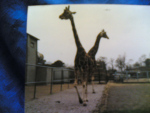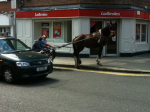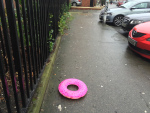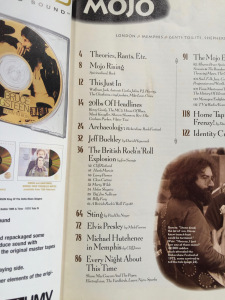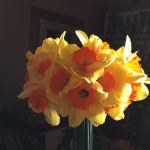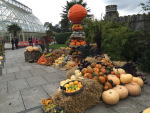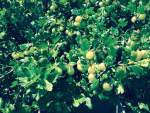Dermott Hayes's Blog: Postcard from a Pigeon, page 78
May 1, 2016
Walking the dogs – Oddball photo challenge
April 30, 2016
Sean McBride – Admiration

Sean McBride was a revolutionary, an international jurist, a Government Minister, a founder member of Amnesty International and the European Court of Human Rights. As a UN Commissioner of Namibia, he was a very vocal opponent of apartheid in South Africa. He was awarded the Nobel Peace Prize in 1974, as a man who “mobilised the conscience of the world in the fight against injustice”. In 1975 he was awarded the Lenin Peace Prize and in 1980, the UNESCO Silver Medal for Service. He was a vocal opponent of nuclear arms. McBride died in 1988, just before his 84th birthday. His mother was Maud Gonne, an Irish nationalist and revolutionary Republican and his father, Major John McBride (in the photo on the mantlepiece, to the left, behind), who was executed by the British in 1916 for his part in the Easter Rising, led the Irish Transvaal Brigade, known as McBride’s Brigade, against the British Empire for the Boers in the Boer war 1898 – 1902.
https://dailypost.wordpress.com/photo-challenges/


The Edge of the World – Solitude
SKELLIG ISLANDS on the south west, Atlantic coast of Ireland has become a familiar site since it was chosen for the closing scene of Star Wars, the Force Awakens. German director, Werner Herzog, used the island for the opening scene of his 1976 film, Heart of Glass. JJ Abrams plans to film there again for the opening scenes of the next Star Wars movie. For more than 1400 years since it was first inhabited, these remote islands have attracted people. The first were hermit monks, seeking SOLITUDE.

Skellig Islands, Irish Central
“But for the magic that takes you out, far out of this time and this world, there is Skellig Michael”
Even George Bernard Shaw conceded that words alone could not capture the awesome splendour of the Atlantic islands of Skellig. There is magic there, the magic of isolation, the feeling of standing on the edge of the world.
If words do exist that describe the primeval sensation of standing atop the larger of the two Skelligs, Skellig Michael, they are probably to be found in the Gaelic language. Sceilig, (pronounced Shkellig) is a word that is as uncompromisingly harsh sounding as the huge splinter of sea rock that it describes. The Scilly Isles, off the western tip of Cornwall, take their name from the same Celtic origin.
The day that our small party took off from Ballinskelligs pier on one of the seven boats that bring visitors, it was ‘a fairly calm day.’ The swell was a cupful less than 20 feet. The Skelligs – Small Skellig and Skellig Michael – lie seven miles off the south west coast of County Kerry, Ireland. Visible from the mainland on just a handful of days in the year, both are virtually inaccessible by sea for all but three months. Even then, the conditions must be right.
The boats make the trip to the Skelligs every day for 2½ months, between June and August, weather permitting. They leave every morning from small ports dotting the Kerry coast – Derrynane, Ballinskelligs and Valentia Island – and they return in the late afternoon, spending the interval, fishing the fish-rich and Gulf-warmed water around the islands.
There were 15 people on our boat that Sunday morning, seven Irish and eight foreign tourists. When we reached the island, I counted 80 visitors.
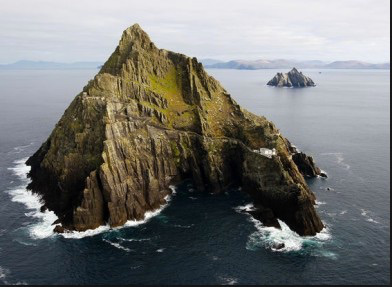
The Journal
The islands, as they appear on the horizon of the giant Atlantic wave troughs, look like the ghostly images of two huge four-masted sailing ships. The impression is enhanced by the centuries old blanket of guano that covers Small Skellig, breeding ground of many ocean birds, stormy petrel, gannets, puffins, razorbills, kittiwakes and the Manx shearwater.
Surrounded by mist and mystery, the history of this island outpost of Europe, begins in the 5th century, when it was colonised by a group of hermit, Christian monks. The myth stretches back further, to the days of the giant hero of Irish folklore, Finn McCool, who fought the King of the World, from the nearby mainland.
There is nowhere to go on Skellig Michael but up – 714 feet and an estimated 44 acres of sheer rock. There is a road, 3,200 feet of it, blasted out of the cliff face that it clings to that winds up to the lighthouses – one, 375 feet above sea level and abandoned since 1866; the other, 175 feet above sea level, still in use and now, fully automatic. In winter, the towering Atlantic waves are so high, the lighthouse keepers had to stay indoors, sometimes for weeks.
While the lighthouse road winds its way around the island, the route upward to the monastic ruins is via the 1,400 year old steps built, or rather hewn, from the bare rock face by those early inhabitants.
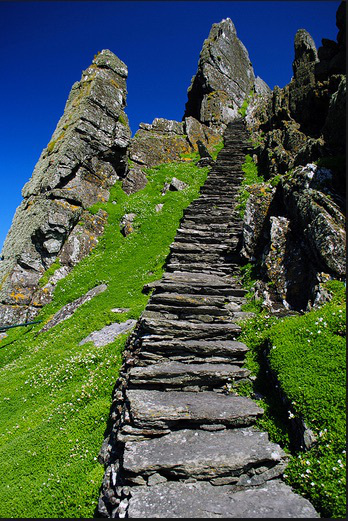
telegraph.co.uk
Looking up, your eyes follow the climbing stairway. Up and up again, until straining for better view, you find yourself leaning dangerously backward.
Two other routes to the top are virtually inaccessible now.
Tourists disembark at Blind Man’s Cove and make their way by the lighthouse road to the beginning of the Southern Stairway. There are 600 steps. There are no railings, no walls, no ditches – just you, the sky, the rock, the sea.
Breathtaking, innervating, thrilling – don’t look up, down, anywhere. Look everywhere. Welcome to the edge of the world.
Already encumbered by excessive baggage and the scorching heat, I was further hampered by a party of tourist, who paused every few minutes, to remark on some aspect of the fauna that had caught their attention. The result was a single file of impatient visitors waiting on a cliff face for the line to advance. As I struggled to keep my balance, I was struck by another group – too young for matrons, too old to be schoolgirls, it was a party of Catholic nuns in mufti.
Sure enough, when we reached the top and the guide from the Office of Public Works had delivered her excellent lecture, the sisters assisted a priest in their company in celebrating an open air mass on the grounds of the monastic ruins.
Bemused tourists looked on. Some kneeled on the hard rock to pray, others set out to explore and still others lay down in the sun.
Asking how or why the monks settled here is a rhetorical exercise. They were members of an eremetical sect – the reclusive life, living here, on the edge of the world, was not an exclusion, I reflected, but an effort to approach their own source essence, their God.
There have been many visitors to the Skelligs since. In the Middle Ages it was a popular place for penitent pilgrimage. Many sailors paid unwitting visits, their ships foundering on the rocks.
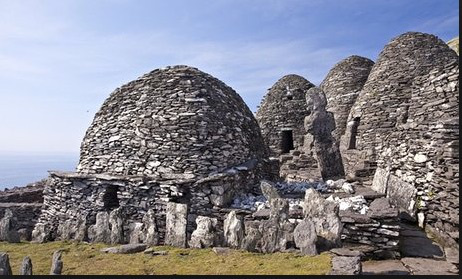
The Guardian
Magic, religion, call it what you like. Ornithologists, archaeologists, chroniclers, writers, pilgrims, druids, kings, Norsemen, monks, fugitives and tourists have been attracted to it through the years.
To the experts, I leave the history and the ornithology, because they are, along with the archaeologists and the lighthouse people, the real keepers of the rock.
“But for the magic that takes you out, far out of this time and this world,” Shaw wrote, “there is Skellig Michael, ten miles off the Kerry coast, shooting straight up, 700 feet, out of the Atlantic. Whoever has not stood in the graveyard on the summit of that cliff, among the beehive dwellings and their beehive oratory, does not know Ireland, through and through.”
As our small boat ploughed a wake through the Atlantic swell, my companions and I felt, in our private reveries that we had, like Shaw, been taken far out there.
(First published in the Washington Post, November 10, 1985, Author: Dermott Hayes)


April 29, 2016
Shane MacGowan and The Popes
Venue: Olympia Theatre, Dublin, January, 1995

THEY CAME, AS IT WERE, FOR THE RESURRECTION AND RESURRECTION – indeed, rampant resurgence – was what they got. Twelve hundred unrepentant pilgrims gathered; grown men were seen to weep in the aisles and then leap onstage, the better to prostrate themselves before the object of their adulation. And then the earth, in the form of 35 seat from the front four rows, was seen to move.
Shane MacGowan returns to Dublin three years since the split with The Pogues and he returns, if the stories are to be believed, from the dead. A month ago, the Irish Advertising Standards Authority had upheld a complaint claiming the billboard campaign of a ‘crucified’ MacGowan, for The Church of the Holy Spook e.p., was blasphemous. But tonight the faithful have assembled and the smoke filled, whiskey and porter stenched air in the cathedral high galleries of this Victorian music hall, scene of many shambolic past triumphs, is redolent with anticipation.
Backstage, in a dressing room tucked away among the labrynthine corridors, noise, smoke and raised voices guide you to a room, modestly tagged, ‘The Popes’. Gathered within are tonight’s celebrants and evidence of the reverentially demolished rider is everywhere. In a corner sits Shane (Il Pappa di tutti Pappas, so to speak), anxiously juggling a jumble of items, to whit: wine, one bottle of; one fag; one set-list; and one pen, felt.
12.45am:, by now the house has begun to reverberate with an animal roar of “SHANE, SHANE, SHANE.”The pit is a seething mass of fans, swaying, swigging and baying: florid of face and, undoubtedly, ‘fluthered’, to a man, woman, unwashed street urchin and, for all one can tell amid the throng, at least one stray sheep.
The show progresses at an amphetamine pace, opening with Streams of Whiskey and thundering through Greenland Whale Fishery and road burning versions of Donegal Express, Church of the Holy Spook and Nancy Whiskey. Centre stage, MacGowan looks very much in control (as much as he can after a lifetime of prodigious hedonism) and as if he’s having fun. ‘Hello, Dublin, it’s good to be back,’ he growls, before breaking in to his familiar Muttley snigger, ‘Ksshsshssh…’
The stage invasions begin with the opening bars of The Snake with the Eyes of Garnet, as fans begin to trampoline from the front rows, over the orchestra pit, over the heads of the bouncers and land at the feet of their hero, this unlikely object of desire. MacGowan continues to sing, unperturbed, as he ducks and dives around the most fervent of his followers. The view from the ornamental theatre box, suspended just above and to the right of the stage, is one of joyous pandemonium. Shane’s girlfriend, Victoria Clarke, sits beside me, nursing a bottle of champagne and decides to shed her knickers and cast them, stage-wards. They float down amid the chaos, a wisp of scanty lace.
In the cockpit below, things are on the borderline of anarchy. More bouncers appear to repel boarders. Occasionally, a gap appears amid the sway to reveal already splintered rows of seating.Everyone’s smiling through two hours, an anarchic reworking of Neil Diamond’s Crackin’ Rosie and two encores of MacGowan penned Pogues’ favourites. His sister, Siobhan, joins him for a version of Fairytale of New York, that is all but drowned by the singing throng.
In the aftermath, a handful of cheery stragglers reel about among the matchwood splinters of the four demolished front rows. Back in the dressing room the air of nervous tension has been replaced by hard-earned euphoria. Arrangements are made for the after show celebrations which should, no doubt, see us into Dublin’s ‘early houses’ by 7am. Victoria and friends decide they’re hungry and head off for a plate of egg ‘n’ chips round at Mr Pussy’s Cafe Deluxe.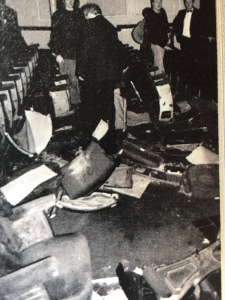
At the door, the maitresse d’ is in a quandary. Fearing a diplomatic incident, she/he whispers how the table adjoining our preferred location, on a secluded balcony, has been booked by a certain party, hereafter referred to as Van Morrison. Spotting the obvious possibilities of such a rock’n’roll encounter, we capture the table. But Van will have none of it; he makes his excuses and leaves, only to turn up, later, at the band’s hotel.
In the residents’ bar of Jury’s Hotel, MacGowan and assorted Popes are ranged about, dazed but delighted, celebratory drinks in hand. Subdued, but satisfied, Shane asks, rhetorically, “What did you think, then?” Then adds, “It’s Dublin, innit? Ksshsshssh”


April 28, 2016
Hugh’s photo challenge: Season
April 27, 2016
Art is the soul (new version)
#WQWWC – Writers Quote Wednesday Writing Challenge – “ARTIST or ART”

With apologies to female artists, this poem is not gender exclusive so, please, feel free to exchange ‘his’ for ‘her’. Also, having slept, fitfully, on this for a few hours, last night, I decided to readdress the subject.
Art is the soul
and the essence
of life.
The artist
bares his soul
to experience
the essence,
then shares it,
that is his art
his soul,
his essence
Art is truth
true art,
without limits,
is relentless
art is beauty,
exposing,
unforgiving
and unfolding
The artist
is the instrument
who reveals
the beauty in truth
Unrelenting,
unforgiving
revealing
and sharing
art is an alliance
of painter
and patron
writer and reader
art is the empire
of the senses
hear it, feel it
see it, sense it
art is life
bleeding and breathing
art is pain
aching and pining
The artist’s the fool,
the hero, the victim
impervious to plaudits
art is the lifeline


Art is the soul
#WQWWC – Writers Quote Wednesday Writing Challenge – “ARTIST or ART”

With apologies to female artists, this poem is not gender exclusive so, please, feel free to exchange ‘his’ for ‘her’.
Art is the soul
and the essence
of life.
The artist
bares his soul
to experience
the essence,
then shares it,
that is his art
his soul,
his essence


An Obstacle is a Challenge
https://dailypost.wordpress.com/discover-challenges/obstacles/
Obstacles are built to go round or over. If you think an obstacle is a deterrent or a barrier, then it has defeated you, already.
When I was 14, my family moved from a small town in the west of Ireland, to the capital city, Dublin. I was half way through my ‘intermediate year’, I suppose fourth grade, if you’re talking High School terms. Back then, classes were determined by an assessment of your academic capability so I was sent to a strange school and into an ‘A’ class where everyone was one year older than me. But by then, I was a veteran of adversity.
Writing has been a passion of mine since I was six years old. In that year, I started my own school newspaper. It was four pages in length and was completely handwritten and then printed on a hand cranked Gestetner. I was in charge of editing and printing as well as reporting, news, sports and miscellaneous school affairs.
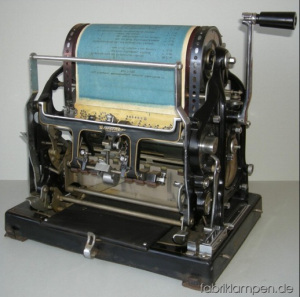
old school, hand cranked Gestetner
After a couple of years and about ten editions – hey, it was hard work and it was a sleepy town – I turned my attention to foreign affairs and international relations.I took a particular interest in the Cultural Revolution in the People’s Republic of China, after seeing a Life Magazine article with pictures of people being paraded, in apparent disgrace, wearing dunces’ hats while young people, in gray pyjamas, marched and shouted, stridently, waving little red books that were, by all accounts, the fountain of great wisdom from the mouth of their leader, Mao Tse Tung, or Mao Zedong, as he’s now known.
So I wrote a letter, addressing it to ‘The Embassy of the People’s Republic of China, London,’ as there was no Chinese embassy in Ireland and, explaining that I was the editor of a school newspaper in the west of Ireland and requested they send me some information about the People’s Republic and particularly, the Cultural Revolution. I said I wanted to understand what these people had done, the people in the dunce’s caps, to be paraded in disgrace and then sent for ‘re-education.’ I forgot to tell them I was eight years old, it didn’t seem relevant to me although, in retrospect, it may have been a mistake. I didn’t tell my parents, either.
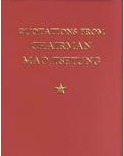
little red book
Two weeks later, a truck pulled up outside my family’s home from which a forklift truck emerged to deliver a weighty crate that was left on our front lawn since the entire house was too small for its contents. When I arrived home from school, my mother and at least two dozen neighbours were standing around this imposing monolith, scratching their heads. I remember recalling this scene when I first saw Stanley Kubrick’s 2001, Space Odyssey. My mother told me to get in the house and wait until my father got home. Which, to be fair, was what I would do, anyway, as my father worked at the nearby airport which was too far away and out of bounds for eight year olds. But I didn’t question her instruction or her logic, I went with the flow and held my counsel.
My father, as it turned out, arrived home sooner than was expected and he arrived with company. The police, as it turned out, since it being a small town, news of a town citizen, albeit an eight year old, receiving crates from the People’s Republic of China, got around. The crate was opened, carefully, a local constable keeping prying neighbours at a safe distance. In hindsight, I’m surprised the army wasn’t called in but those were innocent days.
The crate, it turned out, contained four dozen massive portraits of Mao Zedong and about as many, again, celebrating landmarks of the Long March of communism and its war against Imperialist Dogs, Paper Tigers and several other enemies of the people of China, including a class of dogs who were always running, hence their name, Running Dogs of Capitalism. There were 500 copies of the Quotations of Chairman Mao Zedong, the same little red books so popular with the teenagers in the grey pyjamas and another 500 copies, for distribution, apparently, of The Peking (now Beijing) Daily News, conveniently and helpfully, I thought, translated into English.
I was paraded out to witness what I’d brought upon the good, Catholic citizenry of the town, as though the very presence of these documents would by a magical process of ideological osmosis, turn the entire population into an army of pyjama clad commies. And as the contents of the crate were debated and plans were hatched for a public bonfire, I managed to snatch a copy of the wretched red book, a copy of the condemned Peking Daily News and two of the posters, one of the aforementioned chairman Mao and other of a great dam building project, constructed, apparently, singlehandedly and heroically, by those same grey pyjama clad youths as their other hands were always full with a copy of Mao’s Little Red Book.
The bonfire went ahead that evening, in a field behind our house. There was much merriment and cheer, judging by the noisy whooping that went on, well in to the night. I was not allowed to participate but was sent to bed early, without supper, despite my plea for bread and water, to fulfill my martyr for truth status.

Two days later, when I, as it turned out, misjudged popular sentiment, a special edition of my newspaper was printed, outlining, in detail and editorial outrage, this flagrant attack on the freedom of the fourth estate that, I estimated, was close to Nazi book burning in the 1930s. I was, I must admit now, a precocious pup. I featured an analysis of Mao’s book of wisdom and expressed my outrage at the imprisonment and public disgrace of intellectuals, teachers, lawyers, lecturers and scientists by wet behind the ear, power tripping, brainwashed children in ill fitting and ill matching grey pyjamas. But my pleas went unheeded and I was marched home, in disgrace, by the headmaster of the school. All copies of my newspaper were confiscated and destroyed. Worse still, further publications were strictly prohibited.
Undeterred, I held my counsel and bided my time. Fifty two years later, I am proud to say I spent 25 of those years in pursuit of the truth, as a journalist. It was no obstacle, it gave me inspiration.


Signs Of The Time

My daily visit to my local greengrocer is something I really look forward to, because the music he plays in his shop is great and, sometimes, can inspire a spontaneous sing song among strangers; there’s constant banter and joking, his prices are reasonable and, if you have a special dietary request, he’ll do his best to fill that order for you. On top of that, his window signs, Dublin humour at its best, are guaranteed to brighten your day.
So, I’d like to start a CHALLENGE, I will call it Signs Of The Time. If you find any signs in your neighbourhood that put a smile on your face or a tilt in your kilt and shorten your road, let’s have them


Celtic Heartbeat, in a box
Postcard from a Pigeon
- Dermott Hayes's profile
- 4 followers



